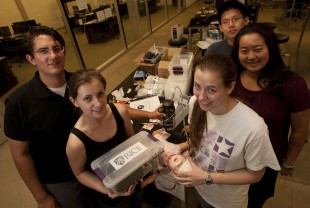Rice 360˚ brings bubble CPAP to help infants with respiratory ailments in Africa
Jocelyn Brown ’10, a staffer at Rice 360˚: Institute for Global Health Technologies, appeared via video at a White House event Feb. 8 to talk about life-saving technology developed by students at Rice University.
Brown was one of four representatives of academic institutions invited to speak at the “Innovations in Global Health” event this week. She is in the African nation of Malawi on behalf of Rice 360˚ and was unable to appear in person, but prepared a video in which she discussed the groundbreaking bubble continuous positive airway pressure (bCPAP) device that provides support for infants whose respiratory systems are compromised.

Rice students at the Oshman Engineering Design Kitchen watch as Jocelyn Brown, an alumna and staff at Rice 360°: Institute for Global Health Technologies, appears via video at a White House conference, "Innovations in Global Health," this week.
The bCPAP was developed by Rice seniors at the Oshman Engineering Design Kitchen as their engineering design capstone project in 2010, and Brown has remained at Rice to continue to develop the device. Also on the team were Rice alumni Michael Pandya, Joseph Chang, Haruka Maruyama and Katie Schnelle. The portable device can be built for $160 and provides the same level of therapeutic pressure as units commonly used in the developed world that cost as much as $6,000, Brown said.
“In my brief time (in Africa) so far, I have seen how quickly babies improve on CPAP and how relieved their mothers feel when their children begin to breathe more easily,” Brown told the White House audience. “The very first patient we put on CPAP was a bronchiolitic baby whose oxygen saturation was dangerously low upon arrival at the hospital. Before starting CPAP, she was nonresponsive, but within minutes of receiving CPAP support, her oxygen levels greatly improved. Just hours later, she was able to nurse, and five days later, she was discharged from the hospital.” Brown said it was amazing to see the baby recover when she had the assistance of the CPAP and did not have to work so hard to breathe.

From left, Rice alumni Michael Pandya, Jocelyn Brown, Katie Schnelle, Haruka Maruyama and Joseph Chang showed components of their bubble continuous positive airway pressure device, developed in 2010 to help infants recover from respiratory infections. Brown, who is in Africa demonstrating the device, appeared via video at a White House conference this week. PHOTO BY JEFF FITLOW
“This is about reducing the costs and improving the results of how we spend taxpayer dollars to achieve development outcomes,” said Rajiv Shah, administrator of the U.S. Agency for International Development (USAID), which selected bCPAP for funding through its Saving Lives at Birth Grand Challenge last July. “But it’s also about offering American students, universities, researchers and entrepreneurs a chance to tap into a set of problems that are fundamentally solvable.”
Saving Lives at Birth is a partnership among USAID, the Government of Norway, the Bill & Melinda Gates Foundation, Grand Challenges Canada and The World Bank.
Rice 360˚ Director Rebecca Richards-Kortum, the Stanley C. Moore Professor of Bioengineering, attended the event on Rice’s behalf.


Leave a Reply